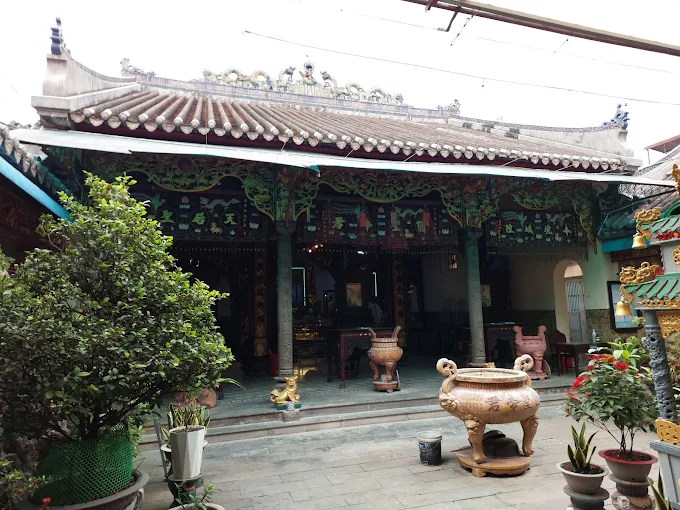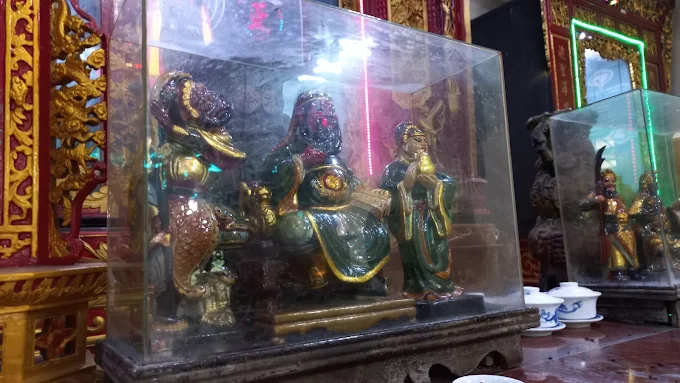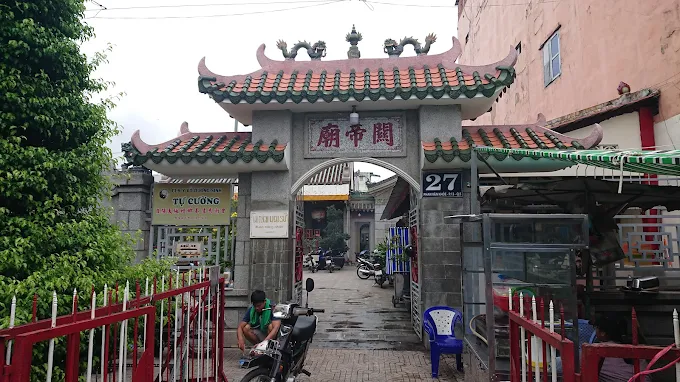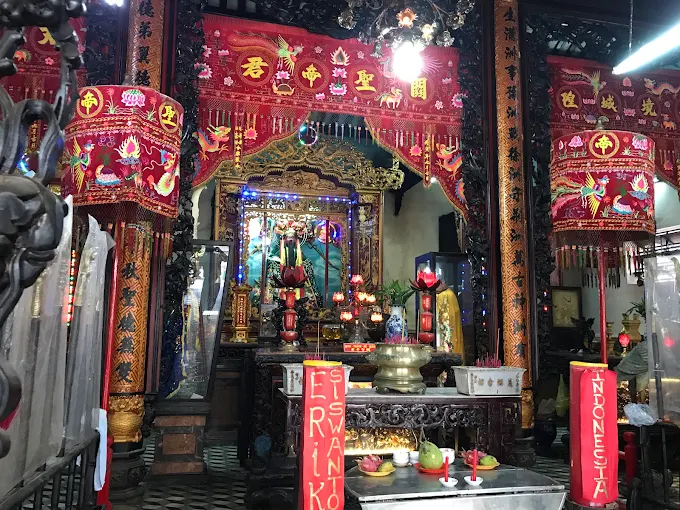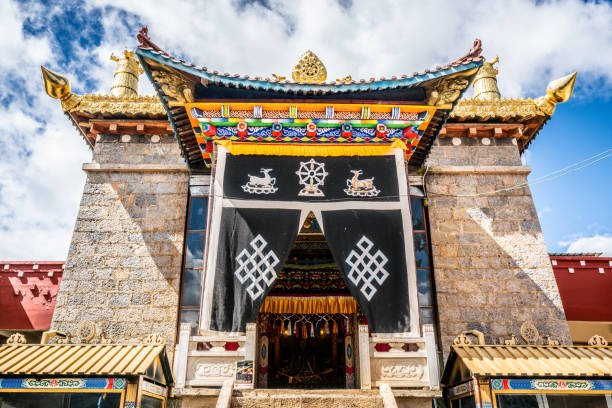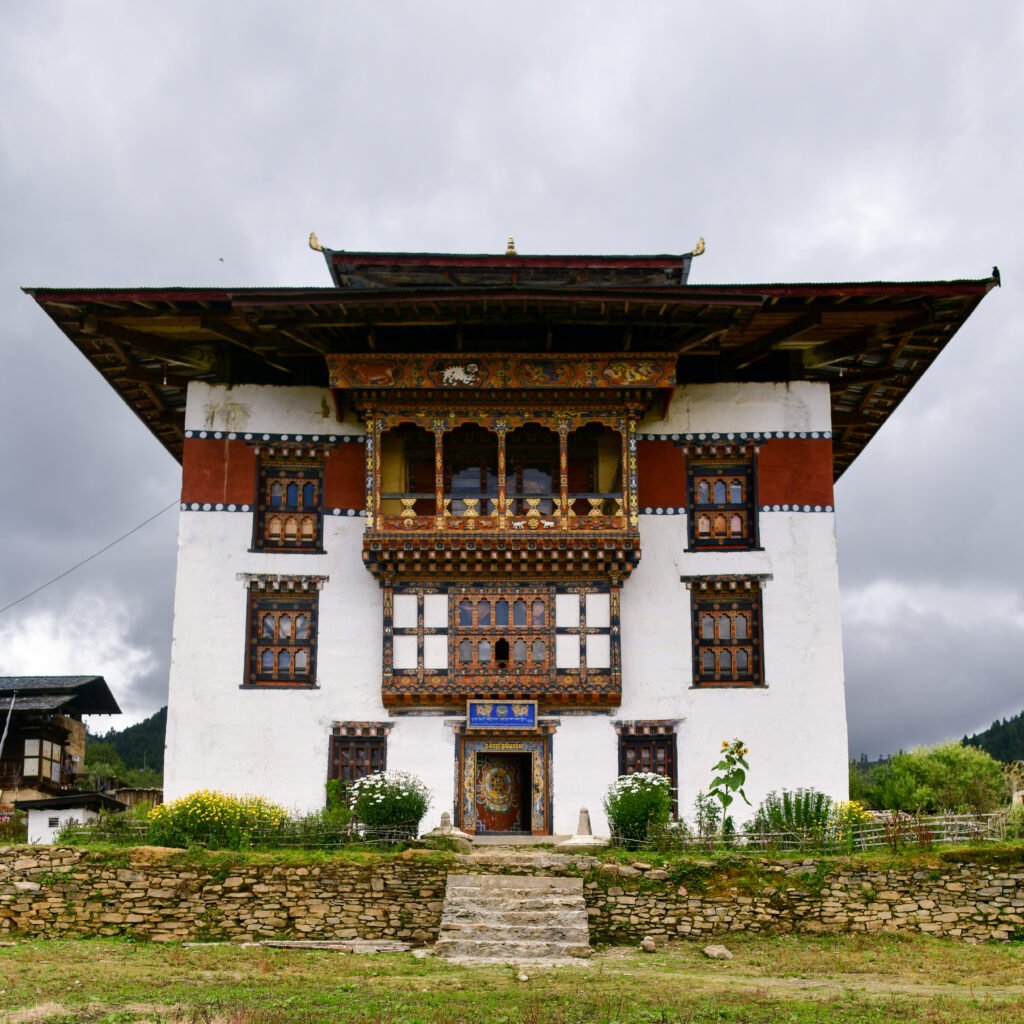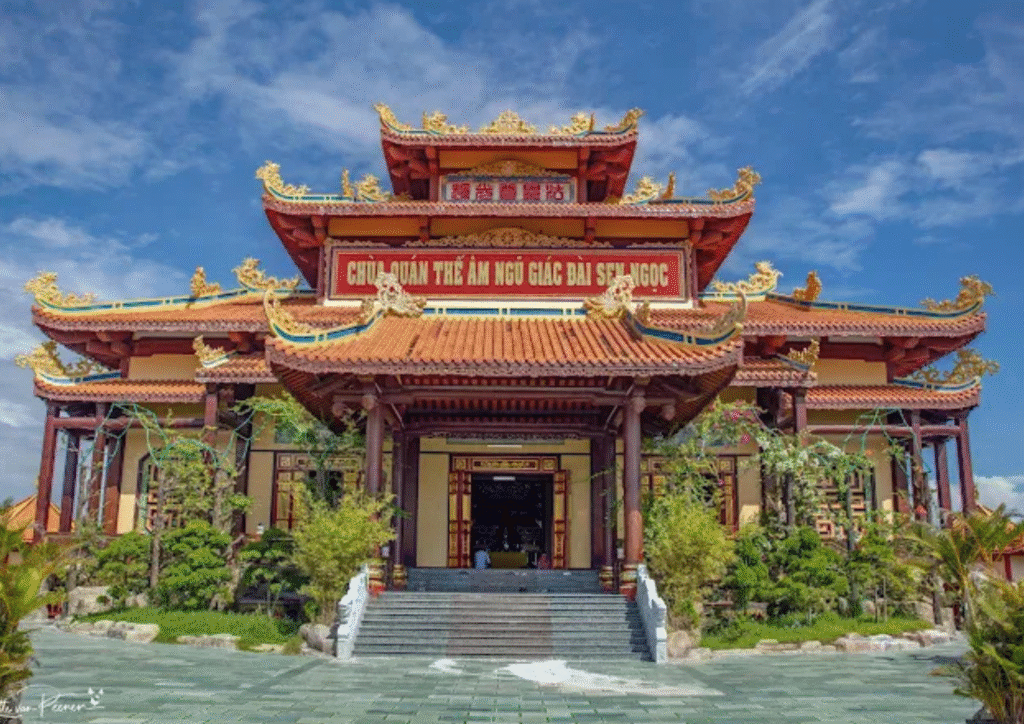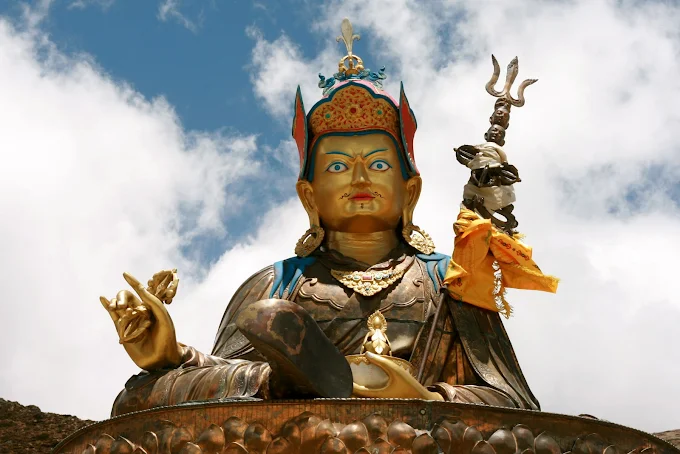Nghĩa Nhuận Pagoda: A Sacred Haven of Teochew Devotion in Chợ Lớn
At 27 Phan Văn Khỏe Street in Chợ Lớn’s vibrant heart, Nghĩa Nhuận Pagoda [Miếu Ông Quan Đế – Hội Quán Nghĩa Nhuận] stands as a sacred haven, its dragon-adorned roof and swirling incense enveloping General Guan Yu’s statue and sacred red horse in Teochew devotion. Monks arrange roasted pig offerings before his altar, while red lanterns cast a warm glow over intricate ceramic carvings. The gentle hum of a 19th-century incense burner blends with prayers, creating a peaceful retreat amid Ho Chi Minh City’s bustling District 5. Built around 1872 by immigrants from Chaozhou, Guangdong, China, and recognized as a national heritage site in 1993, this pagoda weaves Teochew artistry with Buddhist spirituality, inviting visitors to explore Nghĩa Nhuận Pagoda’s rich heritage.
Overview and Significance
Introduction to Nghĩa Nhuận Pagoda
Nghĩa Nhuận Pagoda, also known as Miếu Ông Quan Đế, is a cornerstone of Northern Mahayana Buddhism and Teochew Chinese culture in District 5, Ho Chi Minh City, celebrated for its devotion to General Guan Yu [Quan Công], a historical figure from China’s Three Kingdoms period deified as a symbol of loyalty and bravery. Founded around 1872 by immigrants from Chaozhou, a city in Guangdong Province, China, renowned for its maritime trade and distinct Teochew culture, the pagoda served as a community hall for worship and support, reflecting the Teochew diaspora’s spiritual and cultural heritage. Northern Mahayana, emphasizing compassion and enlightenment, blends with Taoist and Teochew folk beliefs, creating a unique spiritual tapestry. Spanning 2,000 square meters with a 500-square-meter courtyard, the pagoda attracts devotees and tourists for prayer, festivals, and cultural exploration, its red-and-gold Teochew design a hallmark of East Asian artistry. Recognized as a national heritage site in 1993, Nghĩa Nhuận Pagoda anchors Chợ Lớn’s cultural identity, inviting visitors to immerse in its traditions.
The pagoda’s significance lies in its role as a spiritual and community hub for the Teochew community, fostering unity through rituals like roasted pig offerings [heo quay] and festivals such as the Guan Yu Festival [Lễ Vía Quan Công], held on the 24th day of the sixth lunar month, celebrating General Guan Yu with prayers, roasted pig offerings, and dragon dances, uniting the community in devotion. Its main hall, adorned with carved wooden screens [bao lam] and horizontal inscribed boards [hoành phi], showcases centuries of craftsmanship, while its charity, like rice distributions, strengthens its social impact. The courtyard’s stone lions and lake, designed for feng shui [phong thủy], a traditional Chinese practice harmonizing individuals with their environment by balancing energies through spatial arrangement and natural elements, offer a serene space for reflection. Nghĩa Nhuận Pagoda’s blend of history, spirituality, and artistry makes it a must-visit for those seeking to explore Nghĩa Nhuận Pagoda history, connecting Teochew heritage with Vietnam’s vibrant present.
Historical Journey
Nghĩa Nhuận Pagoda’s story began around 1872, when Teochew immigrants from Chaozhou, Guangdong, China, built it as a community hall in Chợ Lớn, originally as the đình of Tân Nhuận village, near Hòa Bình Market. Constructed with wooden beams, stone pillars, and green-glazed tiles, it honored General Guan Yu, the Goddess of the Sea [Thiên Hậu Thánh Mẫu], and the God of Fortune [Phúc Đức Chính Thần], reflecting Chaozhou’s mercantile and martial traditions. A 19th-century stone tablet records donations from Teochew merchants, highlighting early unity, as noted by scholar Vương Hồng Sển.
Renovations in 1879, 1894, 1906, 1911, and 1940 preserved its Teochew architecture, with the 1879 renovation adding ceramic carvings [khắc gốm] like Two Dragons Chasing the Pearl [Lưỡng Long Tranh Châu], as documented in inscriptions. During the 1960s and 1970s, monks hid relics, including a 19th-century bronze incense burner [lư hương], in alcoves to protect them during wartime. The 1940 renovation, funded by community donations, restored the pagoda’s vibrant colors and built the main hall, earning its national heritage status in 1993. Today, the management board oversees charity and cultural activities, keeping the pagoda a spiritual anchor in District 5.
This journey reflects the Teochew community’s resilience, from establishing a new home in Vietnam to safeguarding their heritage. The 1879 renovation added stone lions, enhancing the courtyard’s protective symbolism, while 1940 restored the sacred red horse statue. Each effort preserved the pagoda’s Teochew identity, making it a beacon for those seeking to explore Nghĩa Nhuận Pagoda history and Chợ Lớn’s multicultural past.
Cultural Significance
Nghĩa Nhuận Pagoda is a spiritual haven in District 5, offering peace amid the lively Hòa Bình Market, where vendors’ calls fade into the temple’s calm. Its daily prayers to General Guan Yu, rooted in Northern Mahayana Buddhism and Teochew Taoist traditions, draw devotees seeking courage, loyalty, and protection. The pagoda’s festivals, like the Guan Yu Festival, celebrating loyalty and bravery; the Lantern Festival [Tết Nguyên Tiêu], with vibrant lantern displays and lion dances; the Vu Lan Festival [Lễ Vu Lan], honoring ancestors with offerings of rice, flowers, and roasted pig offerings; and the Hungry Ghost Festival [Cúng Cô Hồn], held on the 15th day of the seventh lunar month, offering food and incense to wandering spirits to ensure their peace, attract thousands from Ho Chi Minh City and beyond. These events unite communities, reflecting Vietnam’s spiritual values.
The pagoda’s unique devotion to General Guan Yu, tied to Teochew martial traditions, sets it apart in Chợ Lớn, as noted in local guides. Its ceramic carvings and calligraphic boards influence the area’s cultural identity, drawing scholars and tourists to explore Nghĩa Nhuận Pagoda’s heritage. Its charity, like rice distributions for District 5’s poor, embeds it in the community, making it a key destination for those seeking to discover its traditions. The pagoda’s vibrant red color, a hallmark of Teochew religious architecture, enhances its allure, creating a serene yet striking presence in Chợ Lớn.
Unique Legacy
Nghĩa Nhuận Pagoda’s legacy blends spirituality, artistry, and resilience:
- General Guan Yu Worship: His statue, with a sacred red horse, symbolizes loyalty and bravery, drawing devotees for courage and justice, a Teochew tradition.
- Community Resilience: Over 150 years, community-funded renovations preserved its heritage through challenges, earning its 1993 heritage status.
- Teochew Artistry: Ceramic carvings and calligraphic boards, blending Chinese and Vietnamese styles, set a cultural standard in Chợ Lớn.
This legacy captivates visitors seeking to explore Nghĩa Nhuận Pagoda history, making it a cultural beacon in District 5.
Community and Global Impact
Nghĩa Nhuận Pagoda fosters community ties in District 5, hosting daily prayers and monthly gatherings that unite Teochew and Vietnamese devotees. During the Guan Yu Festival and Hungry Ghost Festival, diaspora from Singapore and Malaysia join to offer incense, strengthening global ties. Its architecture and charity draw scholars, elevating its profile for those seeking to discover Nghĩa Nhuận Pagoda. Charity initiatives, like rice distributions, make it a vital hub for local and global communities, uniting diverse groups through shared faith and cultural pride.
Historical Anecdotes
- Teochew Devotion: Teochew immigrants built the pagoda around 1872 to honor General Guan Yu, reflecting their martial traditions, as shared by the management board.
- 1879 Donation: A stone tablet records merchant contributions for the first major renovation, symbolizing unity.
- Wartime Preservation: Monks hid relics, like a 19th-century incense burner, during the 1960s–1970s, safeguarding heritage.
These stories enrich Nghĩa Nhuận Pagoda history, captivating visitors.
Social Role
The pagoda hosts charity events, like rice distributions during festivals, aiding District 5 families. Monthly gatherings foster mindfulness, while festivals like the Guan Yu Festival strengthen ties, making it a center for those seeking to immerse in Nghĩa Nhuận Pagoda traditions. Its role as a spiritual hub for Teochew devotees reinforces its social significance.
Artistic Influence
Ceramic carvings and calligraphic boards inspire Chợ Lớn artisans, influencing temple designs. Art exhibitions feature the pagoda’s carved wooden screens, showcasing Nghĩa Nhuận Pagoda architecture’s impact. Its Teochew aesthetics, with vibrant red hues, draw artists and visitors to explore its heritage, perpetuating its influence through local crafts.
The pagoda’s history and culture flow into its architecture, blending spirituality and artistry into a sacred space.
Architectural and Spiritual Features
Iconic Design
Nghĩa Nhuận Pagoda’s Quốc-shaped layout [chữ Quốc], a Chinese design with three parallel buildings forming a rectangular enclosure, spans 2,000 square meters, fostering harmony in temple design with a Teochew style from Chaozhou, Guangdong, China. Its red, gold, and green tiles contrast with District 5’s bustle, creating a striking presence. The dragon-adorned roof, with ceramic carvings of Two Dragons Chasing the Pearl, symbolizes divine power and prosperity. The courtyard’s stone lions, carved in 1879, and the sacred red horse statue create a protective focal point, making Nghĩa Nhuận Pagoda architecture a spiritual haven for devotees and visitors.
The layout includes a front hall, a sky well illuminating the main hall, and east and west wings. Ceramic carvings of mythical creatures like Thanh Long (Azure Dragon) and Bạch Hổ (White Tiger), and stone lions at the entrance, add protection, while red lanterns enhance the spiritual ambiance. Recognized as a national heritage site in 1993, this design invites visitors to explore Nghĩa Nhuận Pagoda architecture’s tranquil beauty, offering a peaceful retreat in Chợ Lớn.
Key Structures
- Main Hall: Adorned with carved wooden screens [bao lam], it houses the General Guan Yu and Goddess of the Sea statues, with a high ceiling amplifying prayers, creating an immersive spiritual experience.
- Front Hall: Features an incense burner [lư hương], flanked by altars to the God of Fortune and Guardians [Hộ Pháp], enhancing the sacred ambiance.
- Sky Well: Illuminates the main hall, enhancing spiritual clarity through feng shui principles.
- East and West Wings: Host community spaces and altars, reflecting the pagoda’s role as a community hall.
These structures anchor Nghĩa Nhuận Pagoda architecture, inviting exploration of its spiritual depth in District 5.
Worshipped Statues/Deities
- General Guan Yu [Quan Công]: A 1.5-meter statue with a sacred red horse symbolizes loyalty and bravery, drawing devotees for courage and justice.
- Goddess of the Sea [Thiên Hậu Thánh Mẫu]: A 1.5-meter statue symbolizes protection, attracting devotees for safe travels and prosperity.
- God of Fortune [Phúc Đức Chính Thần]: A 1.2-meter statue symbolizes wealth, revered for stability and success.
- Guardians [Hộ Pháp]: Statues, including Military Mandarin Chau Xuong, protect the sacred space, enhancing its spiritual ambiance.
These figures inspire reverence, enhancing the appeal for those seeking to visit Nghĩa Nhuận Pagoda.
Materials and Techniques
Ceramic carvings from Guangdong and Bát Tràng resist humidity, depicting Two Dragons Chasing the Pearl, Thanh Long, and Bạch Hổ with vibrant detail, showcasing Teochew artistry. Wooden statues, carved from jackfruit wood [gỗ mít] and gilded with gold leaf, reflect traditional craftsmanship. The 1879 renovation added stone lions and ceramic roof motifs, while the 1940 renovation restored green-glazed tiles and red beams. Horizontal inscribed boards bear prayers like “Nghĩa Nhuận Hội Quán,” showcasing devotion. The 19th-century bronze incense burner adds historical depth, resonating with visitors seeking to explore Nghĩa Nhuận Pagoda architecture.
Signature Elements
The General Guan Yu statue with its sacred red horse, dragon-adorned roof, and stone lions define the pagoda, recognized in its 1993 heritage status, captivating visitors seeking to immerse in its traditions. The vibrant red color, a hallmark of Teochew architecture, makes the pagoda stand out in Chợ Lớn.
Lesser-Known Features
- Stone Lions: Carved in 1879, these statues symbolize protection, often overlooked but cherished for their craftsmanship.
- Sacred Red Horse: A unique statue beside General Guan Yu, symbolizing loyalty, reflects Teochew martial traditions.
- Calligraphic Boards: Boards from the 19th century add cultural richness, bearing prayers in Chinese characters.
These elements enrich the pagoda’s spiritual tapestry, inviting closer exploration for those seeking to visit Nghĩa Nhuận Pagoda.
Preservation Efforts
The 1940 renovation, funded by community donations, restored ceramic carvings and tiles, protecting them from urban pollution and tropical weather. Monks maintain wooden screens with natural oils, ensuring their luster endures. Recent efforts, noted in 2024, include waterproofing the roof to withstand humidity, preserving Nghĩa Nhuận Pagoda for future generations. These initiatives, driven by communal devotion, ensure the pagoda remains a cultural landmark, welcoming visitors to explore its architectural heritage.
Environmental Integration
The courtyard’s stone lions, carved in 1879, and banyan trees create tranquility, aligning with feng shui principles to balance energy. The trees, symbolizing interconnectedness, enhance the spiritual ambiance, shielding the temple from Chợ Lớn’s noise. The sky well’s natural light illuminates the main hall, fostering a connection between nature and spirituality. This harmonious design invites visitors to meditate and reflect, deepening their connection to Nghĩa Nhuận Pagoda’s serene essence for those seeking to visit the pagoda.
Artisan Narratives
Teochew artisans crafted ceramic carvings and wooden screens during the 1879 renovation, embedding prayers into each piece with meticulous care. Local families and vendors contributed materials and labor in 1940, weaving their devotion into the pagoda’s structure, from red lacquered beams to calligraphic lanterns. These artisans, blending Chinese and Vietnamese techniques, created a living testament to cultural fusion, resonating with visitors seeking to explore Nghĩa Nhuận Pagoda architecture.
Symbolic Details
The General Guan Yu statue with its red horse symbolizes loyalty and bravery, the Goddess of the Sea protection, and Two Dragons Chasing the Pearl harmony, deepening the spiritual experience. Red lanterns with calligraphic prayers symbolize hope, their glow enhancing the sacred atmosphere. The stone lions represent protection, rooted in Teochew beliefs, inviting contemplation. These symbols, woven into Nghĩa Nhuận Pagoda architecture, enrich the experience for devotees and visitors.
Landscape Integration
The 2,000-square-meter courtyard, with its stone lions and banyan trees, shields the temple from District 5’s noise, fostering a meditative environment. Stone benches offer quiet spaces for contemplation, while the sky well’s light creates a seamless connection between nature and spirituality. The gentle presence of the lions and red horse adds a tranquil rhythm, enhancing the spiritual ambiance. This harmonious design invites visitors to immerse in Nghĩa Nhuận Pagoda’s serene atmosphere, where the natural and sacred converge.
The architectural splendor of Nghĩa Nhuận Pagoda, from its vibrant ceramic carvings to its tranquil courtyard, creates a sacred stage for the vibrant rituals that animate its spiritual life, inviting visitors to engage with its Teochew traditions.
Rituals and Practices
Daily Sacred Rites
Each morning at 6:00 a.m., monks gather in the main hall to pray to General Guan Yu and the Goddess of the Sea, lighting incense burners to cast a warm glow across their statues, creating a sacred ambiance. Devotees offer roasted pig offerings and sandalwood incense to seek blessings for courage, protection, and prosperity, anchoring Nghĩa Nhuận Pagoda rituals in the community’s spiritual life. The incense burner sends smoke rising as a symbol of devotion, open to visitors with monks’ guidance, fostering a meditative experience.
Monks arrange fresh lotus flowers and fruit offerings, such as mangoes and oranges, before the altars of the God of Fortune and Guardians, symbolizing gratitude and reverence. The daily maintenance of the courtyard reinforces feng shui principles, promoting spiritual harmony. Visitors can participate by offering incense, guided by monks to ensure respectful engagement, creating a serene backdrop that draws those seeking to visit Nghĩa Nhuận Pagoda into its spiritual embrace. The rhythmic chants and the presence of the sacred red horse enhance the tranquil atmosphere, inviting reflection and connection to Teochew traditions.
Unique Practices
- Incense Coil Offerings: Devotees hang large incense coils from the main hall’s ceiling, burning for weeks to seek continuous blessings from General Guan Yu, a Teochew tradition symbolizing enduring devotion. These coils, inscribed with prayers, create a mesmerizing spiral of smoke, open to visitors with monks’ instructions, enhancing the spiritual experience.
- Roasted Pig Offerings: Devotees offer roasted pigs during prayers, a traditional Teochew practice to honor deities, believed to bring prosperity and courage. Placed before the main altar, these offerings are a vibrant expression of gratitude, open to visitors with monks’ guidance, connecting them to Teochew heritage.
- Prayer for Courage: Devotees pray at General Guan Yu’s altar, offering rice and flowers, a Teochew tradition to seek blessings for strength and justice, drawing visitors to participate in this martial ritual.
These distinctive practices, blending Northern Mahayana and Teochew Taoist traditions, distinguish Nghĩa Nhuận Pagoda rituals, captivating those who visit the pagoda.
Festival Traditions
- Guan Yu Festival [Lễ Vía Quan Công]: On the 24th day of the sixth lunar month, prayers, roasted pig offerings, and dragon dances honor General Guan Yu, celebrating loyalty and bravery, drawing crowds to participate in Nghĩa Nhuận Pagoda traditions.
- Lantern Festival [Tết Nguyên Tiêu]: Features vibrant dances and feasts, uniting Chợ Lớn’s community in a joyful gathering.
- Vu Lan Festival [Lễ Vu Lan]: Families offer rice and flowers for ancestors, a profound expression of Buddhist filial piety.
- Hungry Ghost Festival [Cúng Cô Hồn]: On the 15th day of the seventh lunar month, offerings of food and incense honor wandering spirits to ensure their peace, a unique Teochew ritual reflecting compassion, drawing diverse visitors.
These festivals highlight Nghĩa Nhuận Pagoda rituals’ role in uniting District 5’s community and visitors in shared devotion, inviting exploration of its sacred traditions.
Visitor Engagement
Visitors are warmly invited to join morning prayers at 6:00 a.m., guided by monks who provide instructions for respectful participation in Nghĩa Nhuận Pagoda rituals. Offering incense or roasted pig offerings at General Guan Yu’s altar fosters a connection to Teochew traditions. During festivals like the Guan Yu Festival or Hungry Ghost Festival, visitors can join dragon dance celebrations or incense coil offerings, provided they dress modestly (covering shoulders and knees) and maintain silence during prayers. These immersive experiences deepen the spiritual connection for those seeking to visit Nghĩa Nhuận Pagoda, creating lasting memories of its sacred ambiance.
Spiritual Community Roles
- Monks: Lead daily rites, maintain the incense burner, and guide community prayers, ensuring the pagoda’s spiritual continuity with their calm demeanor.
- Devotees: Organize festival preparations, from decorating with lanterns to distributing charitable goods, strengthening community bonds through active participation in Nghĩa Nhuận Pagoda rituals.
- Lay Practitioners [Cư Sĩ]: Lay Practitioner [cư sĩ], a non-monastic member of the Buddhist or Taoist community, actively participates in temple activities without taking monastic vows. These individuals volunteer to organize festivals, maintain temple grounds, or teach cultural traditions, bridging monks and devotees. In Nghĩa Nhuận Pagoda, lay practitioners lead discussions on Teochew heritage, fostering community engagement.
These roles create a vibrant spiritual community, central to those seeking to discover Nghĩa Nhuận Pagoda, uniting diverse groups in compassion and devotion.
Interfaith Connections
Nghĩa Nhuận Pagoda embraces Vietnam’s syncretic spirit, welcoming non-Buddhist locals during festivals like the Hungry Ghost Festival to offer incense, reflecting cultural pluralism. Monks provide blessings to all visitors, fostering interfaith harmony through shared rituals, enhancing the pagoda’s role as a unifying space for those seeking to immerse in Nghĩa Nhuận Pagoda rituals. This openness, rooted in Northern Mahayana’s inclusive philosophy, draws diverse communities to its spiritual warmth.
Ritual Symbolism
The General Guan Yu statue with its red horse symbolizes loyalty and bravery, the Goddess of the Sea protection, and Two Dragons Chasing the Pearl harmony, deepening the spiritual experience. Red lanterns with calligraphic prayers symbolize hope, their glow enhancing the sacred atmosphere. The stone lions represent protection, rooted in Teochew beliefs, inviting contemplation. These symbols, woven into Nghĩa Nhuận Pagoda rituals, enrich the experience for devotees and visitors.
Seasonal Variations
The Guan Yu Festival features dragon dances and offerings, celebrating martial virtues, drawing crowds to Nghĩa Nhuận Pagoda. The Lantern Festival emphasizes vibrant dances and feasts, Vu Lan Festival focuses on ancestral prayers, and the Hungry Ghost Festival honors wandering spirits, creating a contemplative atmosphere. These variations align rituals with Vietnam’s cultural rhythms, offering diverse experiences for those seeking to visit Nghĩa Nhuận Pagoda.
Monastic/Community Life
Monks rise at dawn for prayers, balancing ritual duties with community service, such as organizing charity drives to support the poor in District 5. Devotees volunteer to maintain the courtyard and prepare festival offerings, sustaining the pagoda’s vibrancy. Lay practitioners lead discussions on Teochew heritage, ensuring Nghĩa Nhuận Pagoda rituals remain a living tradition. This vibrant community life draws visitors to immerse in Nghĩa Nhuận Pagoda, fostering a sense of belonging and spiritual growth.
The vibrant rituals of Nghĩa Nhuận Pagoda, from daily prayers to festive celebrations, create a spiritual heartbeat that welcomes all, guiding visitors toward practical engagement with its sacred spaces and Teochew traditions.
Visitor Information
Navigating to Nghĩa Nhuận Pagoda
From Hòa Bình Market, a 7-minute walk along Phan Văn Khỏe Street leads to Nghĩa Nhuận Pagoda’s stone lion-guarded entrance, near Chợ Lớn Post Office. Located in District 5’s Chợ Lớn, close to Hội Quán Ôn Lăng, the pagoda is accessible by foot or motorbike, offering a serene contrast to the bustling markets. Landmarks like Bình Tây Market guide visitors to this spiritual haven, ideal for those seeking to visit Nghĩa Nhuận Pagoda. Vibrant street signs and red lanterns serve as visual cues, ensuring easy navigation through District 5’s lively alleys.
Address of Nghĩa Nhuận Pagoda
27 Phan Văn Khỏe, Ward 13, District 5, Ho Chi Minh City, Vietnam.
Visiting Hours and Etiquette
- Hours: Open daily from 6:00 a.m. to 5:30 p.m., extended to 8:00 p.m. during Guan Yu and Lantern Festivals. Closes 11:00 a.m.–5:00 p.m. on Lunar New Year’s Eve for cleaning, reopening for continuous worship on the first day.
- Etiquette: Remove shoes before entering the main hall, dress modestly (covering shoulders and knees), and maintain silence during prayers to respect the pagoda’s sanctity.
- Cultural Tips: Bow slightly when approaching statues, avoid touching sacred objects like the incense burner or red horse, and ask monks’ permission before participating in rituals like roasted pig offerings or incense coil offerings, aligning with Teochew customs.
These guidelines ensure a respectful experience for those seeking to visit Nghĩa Nhuận Pagoda.
Transport Options
- Motorbike: Parking available near the entrance (5,000 VND), ideal for navigating Chợ Lớn’s narrow alleys.
- Taxi/Grab: A 10-minute ride from District 1, convenient for international visitors seeking to explore Nghĩa Nhuận Pagoda.
- Bus: Routes 01, 45, or 56 stop near Phan Văn Khỏe Street, a 5-minute walk from the pagoda (5,000–7,000 VND).
- Walking: A 12-minute walk from Bình Tây Market immerses visitors in Chợ Lớn’s culture, enhancing the experience of exploring Nghĩa Nhuận Pagoda.
These options make visiting Nghĩa Nhuận Pagoda accessible, enriching the journey to discover its heritage.
Accessibility and Safety
- Accessibility: The courtyard and front hall accommodate wheelchairs, but the main hall requires climbing steps. Monks can assist with ground-floor prayer spaces for accessibility.
- Safety: District 5 is generally secure, but visitors should watch for motorbike traffic on Phan Văn Khỏe Street and secure bags in crowded markets to prevent pickpocketing.
These considerations ensure a safe and inclusive experience for those seeking to visit Nghĩa Nhuận Pagoda.
Amenities and Surroundings
- Amenities: Restrooms and a small tea stall in the courtyard offer refreshments, with stone benches for contemplation near the stone lions, enhancing the serene experience of visiting Nghĩa Nhuận Pagoda.
- Surroundings: Hòa Bình Market, 0.7 km away, offers vibrant street food like bánh xèo and phở, immersing visitors in Chợ Lớn’s culinary culture, complementing the journey to explore Nghĩa Nhuận Pagoda. Nearby Hội Quán Ôn Lăng (0.5 km) provides additional cultural context.
Immersive Visitor Tips
To deepen the experience of visiting Nghĩa Nhuận Pagoda, join morning prayers at 6:00 a.m., guided by monks, or offer incense at General Guan Yu’s altar for blessings of courage and protection. During festivals like the Guan Yu Festival or Hungry Ghost Festival, participate in dragon dance celebrations or incense coil offerings, following monks’ instructions. Meditate by the stone lions, reflecting on their protective symbolism, or photograph the ceramic carvings at dusk, when soft light highlights their Two Dragons Chasing the Pearl motifs, connecting to the pagoda’s serene spirit. Avoid peak festival crowds for a quieter visit, ensuring a deeper connection to Nghĩa Nhuận Pagoda.
Nearby Cultural Experiences
- Hòa Bình Market (0.7 km): Offers local cuisine, from tropical fruits to bún bò Huế, immersing visitors in Chợ Lớn’s vibrant culture.
- Bình Tây Market (0.9 km): A historic market with textiles, spices, and cultural artifacts, enriching the context for those visiting Nghĩa Nhuận Pagoda.
- Hội Quán Ôn Lăng (0.5 km): A nearby pagoda dedicated to the Goddess of the Sea, offering complementary insights into Chợ Lớn’s Teochew heritage.
These sites enrich the experience of visiting Nghĩa Nhuận Pagoda with vibrant cultural immersion.
Photography Tips
Capture the main hall’s ceramic carvings in natural light, ideally at sunrise or dusk, to highlight their intricate Two Dragons Chasing the Pearl motifs. Avoid flash photography near statues, especially the sacred red horse, to respect sacred spaces, and focus on the stone lions for reflective shots that capture the pagoda’s serene ambiance. Ask permission before photographing monks or devotees, ensuring a respectful approach for those seeking to visit Nghĩa Nhuận Pagoda. The red lanterns, glowing against the vibrant architecture, offer striking compositions at twilight.
The practical guidance for visiting Nghĩa Nhuận Pagoda paves the way for a deeper understanding of its spiritual and cultural significance, inviting reflection on its Teochew traditions and fostering a meaningful connection to its sacred heritage.
Cultural and Spiritual Insights
Religious Philosophy
The worship of General Guan Yu and the Goddess of the Sea at Nghĩa Nhuận Pagoda, rooted in Northern Mahayana Buddhism and Teochew Taoist traditions, emphasizes loyalty, bravery, and protection, inspiring devotees to uphold ethical values and seek divine guidance. Daily prayers and roasted pig offerings reflect the pagoda’s mission to foster courage and prosperity, drawing visitors to immerse in its spiritual depth. The sacred red horse, unique to Teochew worship, encourages reflection on martial virtues, making Nghĩa Nhuận Pagoda a vital destination for those seeking to discover its heritage and connect with its spiritual core.
Environmental Spirituality
The courtyard’s stone lions, carved in 1879, and banyan trees symbolize protection and interconnectedness, aligning with feng shui principles to balance energy, inviting meditation for those seeking to visit Nghĩa Nhuận Pagoda. The sky well’s natural light fosters a connection between nature and spirituality, deepening the visitor’s experience and enhancing the spiritual ambiance.
Artistic Symbolism
The ceramic carvings of Two Dragons Chasing the Pearl represent harmony and prosperity, deepening spiritual contemplation and connecting visitors to Teochew folklore. Red lanterns with calligraphic prayers symbolize hope, their glow illuminating the sacred spaces. The stone lions and sacred red horse signify protection and loyalty, rooted in Teochew beliefs, enhancing the pagoda’s spiritual allure. These artistic elements, woven into Nghĩa Nhuận Pagoda architecture, enrich the spiritual experience for visitors, linking them to its cultural heritage.
Community Resilience
The pagoda’s survival through over 150 years, supported by community donations during renovations like those in 1879 and 1940, showcases enduring faith and resilience. Stories of Teochew immigrants founding the pagoda and wartime relic preservation highlight collective devotion, strengthening Nghĩa Nhuận Pagoda’s role as a community anchor for those seeking to explore its heritage. This resilience unites District 5’s diverse community in shared faith and cultural pride, fostering a sense of belonging.
Environmental Stewardship
Monks maintain the courtyard and stone lions using sustainable practices, such as natural cleaning methods for ceramic carvings, reflecting Taoist and Buddhist principles of environmental care. These efforts ensure the pagoda remains a serene sanctuary, inviting visitors to discover Nghĩa Nhuận Pagoda’s ecological harmony and spiritual tranquility, and fostering a deeper connection to its natural and sacred elements.
Meditative Practices
Morning prayers at 6:00 a.m., open to visitors, focus on mindfulness and protection, guided by monks in the main hall. These practices, rooted in Northern Mahayana and Teochew traditions, foster inner peace, offering a profound experience for those seeking to visit Nghĩa Nhuận Pagoda. The rhythmic chants and serene ambiance connect participants to the pagoda’s spiritual core, encouraging contemplation and spiritual growth.
Cultural Narratives
Stories of Teochew immigrants founding the pagoda in 1872 and the 1879 renovation recorded on a stone tablet enrich Nghĩa Nhuận Pagoda history. Tales of monks hiding relics during wartime add a layer of resilience, resonating with devotees and visitors seeking to explore its heritage. These narratives captivate with their depth and cultural significance, offering a window into the pagoda’s enduring legacy and its role in Chợ Lớn’s cultural tapestry.
Historical Context
Nghĩa Nhuận Pagoda’s growth mirrors Chợ Lớn’s evolution as a Chinese cultural hub, reflecting Vietnam’s multicultural history post-1872. Its role as a community hall underscores the Teochew community’s contributions to southern Vietnam, from trade to cultural preservation, anchoring those seeking to discover Nghĩa Nhuận Pagoda in a broader historical narrative of cultural fusion and resilience.
These insights deepen appreciation for Nghĩa Nhuận Pagoda’s spiritual and cultural role, inviting reflection on its enduring significance as a beacon of loyalty, protection, and heritage in District 5.
Conclusion
Nghĩa Nhuận Pagoda, with its radiant General Guan Yu statue and sacred red horse, shines as District 5’s spiritual heart, blending Teochew devotion with artistry. From its 1872 founding by Chaozhou immigrants to its 1993 heritage status, it reflects enduring faith, its rituals and architecture weaving loyalty and prosperity. The stone lions’ protective presence and festivals like the Guan Yu Festival and Hungry Ghost Festival invite visitors to explore a sanctuary of peace, where incense coils and roasted pig offerings resonate with centuries of tradition. Nghĩa Nhuận Pagoda welcomes all to immerse in its sacred heritage, offering a profound connection to Chợ Lớn’s vibrant cultural tapestry.
